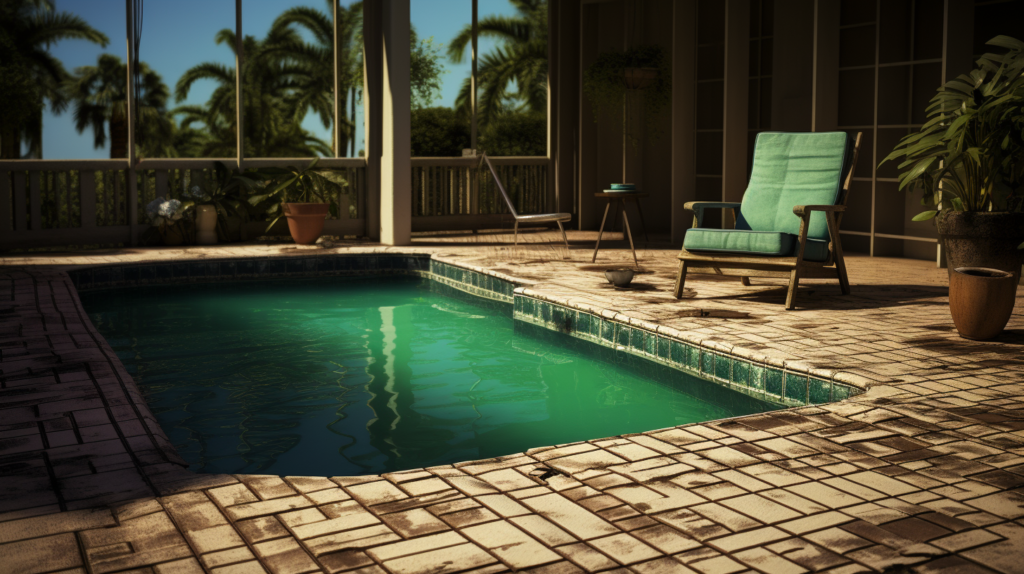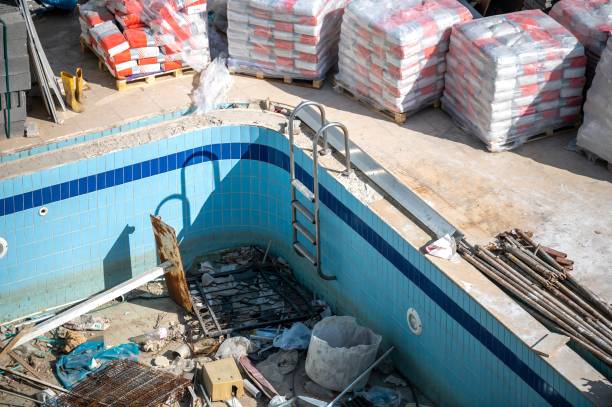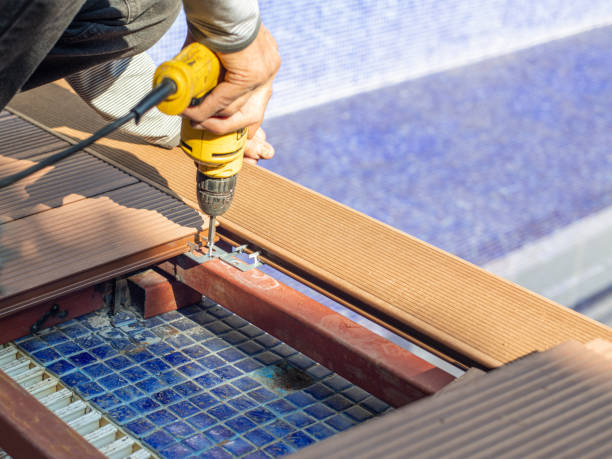As you dive into the crystal-clear waters of your concrete pool, you notice a faint crack running along the edge, like a subtle reminder of time passing.
But this is just the beginning. There are other signs, more hidden, that indicate your pool needs a renovation.
From faded tiles to outdated equipment, these subtle hints can significantly impact the overall enjoyment and safety of your swimming experience.
So, before you take another refreshing dip, addressing these signs head-on is crucial and ensuring your pool remains a pristine oasis.
Cracks in the Pool Structure
If you notice cracks in your pool structure, addressing them promptly is important to prevent further damage. Cracks in a concrete pool can indicate underlying issues that need immediate attention. These cracks can allow water to seep into the pool’s foundation, leading to more extensive and costly damage.
Cracks can also be a safety hazard, as they can cause tripping or sharp edges that can injure swimmers. To address cracks in your pool structure, it’s recommended to consult a professional pool renovation company. They have the expertise to assess the severity of the cracks and provide the appropriate repairs or renovations needed to ensure the structural integrity of your pool.
Faded or Discolored Tiles
When the tiles in your concrete pool start to fade or become discoloured, it’s essential to address this issue promptly to maintain your pool’s overall appearance and quality.
Faded or discoloured tiles not only detract from the aesthetic appeal of your pool but can also indicate underlying problems. Discoloration can occur for various reasons, such as exposure to harsh chemicals, UV rays, or improper maintenance. Over time, these factors can cause tiles to lose their original colour and become dull or stained.
If left unattended, the discolouration can spread, affecting a larger area and making restoring the tiles to their former glory more challenging. By promptly addressing faded or discoloured tiles, you can ensure that your pool remains visually appealing and retains its value.
Excessive Wear and Tear
Excessive wear and tear in your concrete pool can significantly impact its overall longevity and functionality.
Over time, constant use, exposure to chemicals, and harsh weather conditions can lead to cracks, chips, and surface deterioration. These signs of wear and tear not only compromise the aesthetic appeal of your pool but also pose safety risks for swimmers. Cracked or chipped concrete can cause cuts and injuries, while surface deterioration can make the pool more difficult to clean and maintain.
Additionally, excessive wear and tear can affect the pool’s structural integrity, leading to leaks and water seepage. If you notice any signs of wear and tear in your concrete pool, addressing them promptly is crucial to prevent further damage and ensure the pool’s longevity and functionality.
Leaking or Loss of Water
Leaking or losing water in your concrete pool can be a major indicator of underlying problems requiring immediate attention. If you notice a significant drop in water level, it’s crucial to investigate the cause immediately.
Leaks can occur due to cracks in the pool’s structure, faulty plumbing, or damaged fittings. These issues can lead to further damage if left unaddressed, such as erosion of the pool’s foundation or damage to nearby structures.
Water loss can also result in increased water bills and the need for more frequent refilling. To prevent further complications and ensure the longevity of your pool, it’s important to consult professionals who specialize in pool repairs and renovations.
Outdated or Inefficient Pool Equipment
If your concrete pool equipment is outdated or inefficient, it may be time for an upgrade. Outdated or inefficient pool equipment can significantly impact your pool’s overall performance and functionality.
For instance, an outdated pool pump may not circulate the water effectively, leading to poor filtration and water quality issues. Inefficient pool heaters can result in higher energy bills and longer heating times, making it less enjoyable to swim in colder months.
Additionally, outdated or inefficient pool equipment may not comply with current safety and energy efficiency standards. Upgrading your pool equipment can improve its performance, save on energy costs, and ensure a safer swimming experience for you and your family.
Deteriorating Pool Surface
Upgrading your outdated or inefficient pool equipment can greatly improve your pool’s overall performance and functionality. It’s also important to address another potential issue: a deteriorating pool surface. The surface of your concrete pool can experience wear and tear over time due to exposure to harsh chemicals, weather conditions, and general use.
Signs of a deteriorating pool surface include cracks, chipping, peeling, or rough texture. Not only do these issues affect the aesthetics of your pool, but they can also pose safety risks. Cracked or rough surfaces can cause cuts or abrasions, and chipped or peeling areas can harbour bacteria and algae growth.
If you notice any of these signs, it’s crucial to renovate your pool surface to ensure its longevity, safety, and visual appeal.
Poor Water Quality or Algae Growth
Addressing poor water quality or algae growth in your pool is essential to ensure clean and clear water.
If you notice that your pool water is murky, discoloured, or has a strong odour, it clearly indicates poor water quality. Various factors, such as improper pH balance, inadequate filtration or circulation, or a buildup of contaminants, can cause this.
Additionally, algae in your pool is a common problem that can lead to poor water quality. Algae growth can occur due to insufficient sanitization or inadequate pool maintenance. If left untreated, algae can multiply rapidly, making your pool water unsafe for swimming.
To restore your pool’s water quality and prevent algae growth, consider renovating your concrete pool to ensure proper filtration, sanitation, and maintenance practices.
Safety Hazards or Noncompliance With Regulations
Addressing safety hazards and ensuring compliance with regulations is crucial when renovating your concrete pool. Neglecting these aspects can lead to serious accidents and legal liabilities.
One common safety hazard is the presence of cracked or damaged pool surfaces. These can cause cuts and abrasions to swimmers, posing a risk of infection or injury.
Another concern is the lack of proper fencing or barriers around the pool area. This can result in unintentional access by children or pets, increasing the risk of drowning.
In addition, noncompliance with regulations regarding pool depth, water circulation, and filtration systems can compromise the safety and health of pool users.
Difficulty Maintaining Proper Water Balance
Maintaining proper water balance in your concrete pool can be challenging without proper knowledge and maintenance. It could be a sign that your pool needs renovation if you find it difficult to balance the water.
The water balance refers to the pool water’s pH level, alkalinity, and calcium hardness. When these levels aren’t properly maintained, it can lead to various issues. For example, a high pH level can cause scaling and cloudy water, while a low pH level can lead to corrosion and skin irritation.
Additionally, imbalanced water can negatively affect the effectiveness of your pool chemicals, making it harder to keep the water clean and safe. Therefore, if you struggle to maintain proper water balance, it may be time to consider renovating your concrete pool.
Unattractive or Outdated Pool Design
If your concrete pool’s water balance is consistently off, it may be time to consider renovating due to an unattractive or outdated pool design. An unattractive pool design can be a major deterrent to enjoying your pool and make your backyard look less appealing.
The design of your pool should be visually appealing and complement the overall aesthetic of your outdoor space. An outdated design can make your pool seem old-fashioned and out of touch with current trends. By renovating your pool, you can update its design and make it more visually pleasing.
This can include changing the shape, size, or layout of your pool and updating the materials used for the pool’s surface or surrounding areas. A renovated pool with a modern and attractive design can enhance the overall look and feel of your backyard and make it a more enjoyable space for you and your family.
Frequently Asked Questions
How Much Does It Typically Cost to Renovate a Concrete Pool?
Typically, how much does it cost to renovate a concrete pool?
Well, it depends on various factors, such as the size of the pool, the extent of the renovations needed, and your location.
Can I Renovate My Concrete Pool, or Should I Hire a Professional?
You can renovate your concrete pool, but hiring a professional is recommended. They have the expertise and tools to ensure a successful renovation.
Considering your skills and knowledge before taking on such a project is important.
What Are the Most Common Causes of Cracks in a Concrete Pool Structure?
Various factors can cause cracks in a concrete pool structure. These factors include ground movement, improper installation, or aging.
It’s essential to identify and address these issues promptly. Doing so will prevent further damage.
Are Any Eco-Friendly or Energy-Efficient Options Available for Updating Pool Equipment During a Renovation?
Eco-friendly and energy-efficient options are available for updating pool equipment during a renovation.
These options can help reduce your carbon footprint and save you money on energy bills in the long run.
What Steps Can Be Taken to Prevent Algae Growth and Maintain Good Water Quality in a Renovated Concrete Pool?
To prevent algae growth and maintain good water quality in a renovated concrete pool, there are several steps you can take.
First, cleaning and scrubbing the pool’s surfaces regularly is important. This will remove any dirt or debris that could provide a breeding ground for algae. You can use a pool brush or vacuum to clean the walls and floor of the pool.
Next, it is crucial to balance the pH and chlorine levels in the pool. Algae thrive in water that is too alkaline or has insufficient chlorine levels. You should regularly test the water and adjust the pH and chlorine levels.
Finally, using a pool cover when the pool is not in use can also help prevent algae growth. A pool cover will block sunlight, which algae need to grow. It will also prevent debris from falling into the pool, reducing the chances of algae growth.
Conclusion
If you notice any of these signs in your concrete pool, it’s time for a renovation.
Cracks in the pool structure, faded tiles, excessive wear and tear, and leaking or water loss indicate that your pool needs some attention.
Outdated or inefficient pool equipment, poor water quality or algae growth, safety hazards, difficulty maintaining proper water balance, and an unattractive or outdated pool design are signs of a makeover.
Don’t wait until it’s too late; take action to ensure your pool is safe and enjoyable for years.








